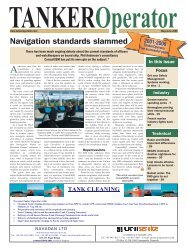Features: - Tanker Operator
Features: - Tanker Operator
Features: - Tanker Operator
Create successful ePaper yourself
Turn your PDF publications into a flip-book with our unique Google optimized e-Paper software.
TECHNOLOGY - TANK CLEANING<br />
How efficient are<br />
cargo tank cleaning<br />
chemicals?<br />
Understanding what is required to clean between different grades of liquid cargo on a<br />
tanker is challenging enough when one considers the various elements that usually have<br />
to be taken into consideration before a tank cleaning operation.*<br />
The four main checklists that should<br />
be considered are:-<br />
1) The chemical and physical<br />
properties of the cargo being<br />
cleaned.<br />
2) The chemical and physical properties of<br />
the next nominated cargo; which will<br />
directly impact on the type, duration and<br />
intensity of the necessary cleaning.<br />
3) The material with which the cargo tank is<br />
lined; stainless steel, organic coating,<br />
inorganic coating, other specialised<br />
coating.<br />
4) The experience of the crew carrying out<br />
the cleaning operation.<br />
But throw into the equation the massive<br />
choice and variety of branded and nonbranded<br />
tank cleaning chemicals and the<br />
degree of complexity moves to another level.<br />
If one considers only the branded cleaning<br />
chemicals, there are literally hundreds to<br />
choose from, all apparently available for the<br />
purpose of cleaning cargo tanks. As one might<br />
expect with such a large number of products<br />
available, there is a considerable price<br />
differential between the various products and<br />
their respective suppliers; with most suppliers<br />
claiming that their products are better than<br />
their competitors.<br />
Cleaning chemicals are usually used when a<br />
vessel is cleaning from a cargo that is oil<br />
based and/or insoluble in water and with this<br />
in mind, they are generally termed as<br />
‘hydrocarbon removers’ or ‘degreasers’. They<br />
are diluted in water and applied to the<br />
contaminated cargo tanks either by means of<br />
recirculation, direct injection into the vessel’s<br />
tank cleaning system or by manual<br />
application, depending on the extent and the<br />
severity of the contamination.<br />
The majority of cleaning chemicals contain<br />
detergents, although perhaps a more accurate<br />
name would be surface active agents, based<br />
What is needed is a cleaning chemical that effectively cleans the bulkhead surfaces –<br />
surface active cleaners, explained L&I Maritime.<br />
on the mechanism that makes them effective<br />
as cleaning agents.<br />
Basically, when we say a cargo tank is<br />
contaminated with a previous cargo, it is<br />
actually the cargo tank bulkheads that we are<br />
talking about. So clearly what is needed is a<br />
cleaning chemical that effectively cleans the<br />
surfaces of the bulkheads, hence the need for<br />
surface active cleaners.<br />
It should also be considered that the internal<br />
surface area of any cargo tank is relatively<br />
small compared to the volume, which means<br />
that only relatively low concentrations of<br />
detergents should be required to effectively<br />
clean any particular cargo tank. However, in<br />
order to maintain recirculation inside a cargo<br />
tank, or optimise the working pressure of a<br />
tank cleaning system, significant volumes of<br />
water need to be used on board vessels and<br />
this can and does have a significant impact on<br />
the amount of cleaning chemicals that are<br />
required for any particular operation.<br />
But now the actual mechanism that makes<br />
detergents effective should be considered. It is<br />
found that the surface active agents in the<br />
cleaning chemical become concentrated at the<br />
oil-water interface, thereby applying the<br />
necessary cleaning action at the place where it<br />
is most required, which in the case of a cargo<br />
tank, is the internal surfaces of the bulkheads.<br />
So even if large volumes of water are required<br />
to ‘carry’ the cleaning chemicals, the amount<br />
of detergent required to effectively clean the<br />
cargo tanks is not directly related to this<br />
volume, it is related to the surface area of the<br />
cargo tanks.<br />
No magic formula<br />
Unfortunately, there is no magic formula that<br />
can be used to indicate the most effective<br />
concentration of cleaning chemical for a cargo<br />
tank (based on its size), but it should be<br />
accepted that the most effective detergents are<br />
‘most effective’ at low concentrations and if a<br />
cargo tank can be cleaned with 50 litres of<br />
cleaning chemical, this will be largely the<br />
same irrespective of the volume of water in<br />
which the cleaning chemical is diluted.<br />
It should be noted that this theory only<br />
applies to surface active cleaners, but<br />
November/December 2009 TANKER<strong>Operator</strong> 27

















